传统文化京剧的介绍(传统文化京剧的介绍英语)
用英文介绍中国文化京剧精髓
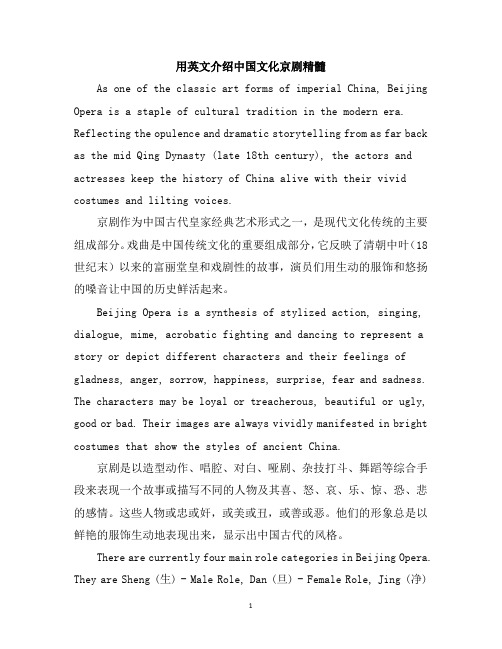
用英文介绍中国文化京剧精髓As one of the classic art forms of imperial China, Beijing Opera is a staple of cultural tradition in the modern era. Reflecting the opulence and dramatic storytelling from as far back as the mid Qing Dynasty (late 18th century), the actors and actresses keep the history of China alive with their vivid costumes and lilting voices.京剧作为中国古代皇家经典艺术形式之一,是现代文化传统的主要组成部分。
戏曲是中国传统文化的重要组成部分,它反映了清朝中叶(18世纪末)以来的富丽堂皇和戏剧性的故事,演员们用生动的服饰和悠扬的嗓音让中国的历史鲜活起来。
Beijing Opera is a synthesis of stylized action, singing, dialogue, mime, acrobatic fighting and dancing to represent a story or depict different characters and their feelings of gladness, anger, sorrow, happiness, surprise, fear and sadness. The characters may be loyal or treacherous, beautiful or ugly, good or bad. Their images are always vividly manifested in bright costumes that show the styles of ancient China.京剧是以造型动作、唱腔、对白、哑剧、杂技打斗、舞蹈等综合手段来表现一个故事或描写不同的人物及其喜、怒、哀、乐、惊、恐、悲的感情。
关于介绍高中京剧的80字英语作文儿

高中京剧:传统艺术的传承与创新In high school, Peking Opera, a unique form of traditional Chinese theatre, is often introduced to students as a way to appreciate the rich cultural heritage of the country. With its vibrant costumes, intricate facial paintings, and melodious singing, Peking Opera tellsstories of heroes and villains, love and hate, joy and sorrow. In high school, students are encouraged to watch performances, learn about the history and techniques behind it, and even participate in drama clubs to experience the art form hands-on. This not only helps them understand and appreciate their own culture better but also fosters creativity and teamwork skills through dramatic performances. The combination of traditional music, dance, acrobatics, and acting in Peking Opera makes it a thrilling and engaging performance that continues to captivate audiences, especially the younger generation, in high schools across China.在中国的高中,京剧这一独特的中国传统戏剧形式经常被介绍给学生们,以此让他们欣赏到国家丰富的文化遗产。
京剧简短介绍英文作文
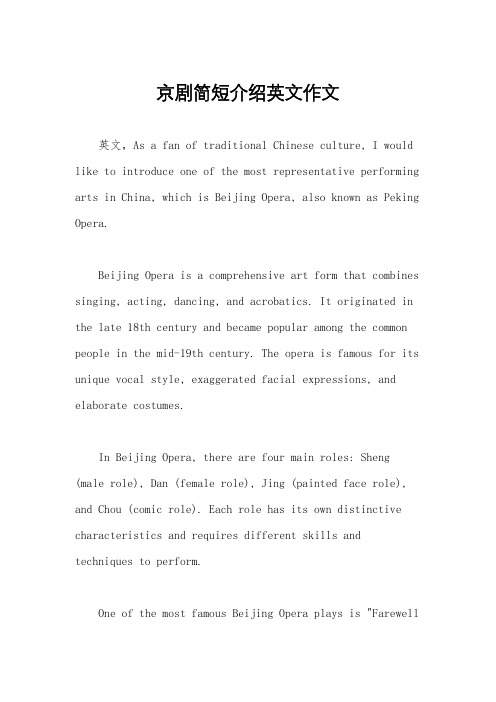
京剧简短介绍英文作文英文,As a fan of traditional Chinese culture, I would like to introduce one of the most representative performing arts in China, which is Beijing Opera, also known as Peking Opera.Beijing Opera is a comprehensive art form that combines singing, acting, dancing, and acrobatics. It originated in the late 18th century and became popular among the common people in the mid-19th century. The opera is famous for its unique vocal style, exaggerated facial expressions, and elaborate costumes.In Beijing Opera, there are four main roles: Sheng (male role), Dan (female role), Jing (painted face role), and Chou (comic role). Each role has its own distinctive characteristics and requires different skills and techniques to perform.One of the most famous Beijing Opera plays is "FarewellMy Concubine," which tells the story of a general who is forced to leave his beloved concubine to save his country. The play features beautiful singing, graceful dancing, and touching acting, and has been adapted into a movie and an opera.I have always been fascinated by Beijing Opera because of its rich cultural heritage and artistic value. Whenever I watch a Beijing Opera performance, I am amazed by the performers' skills and the beauty of the art form.中文,作为一名中国传统文化的爱好者,我想介绍一种中国最有代表性的表演艺术形式——京剧,也被称为北京戏。
八年级下册京剧传统文化英语作文及译文
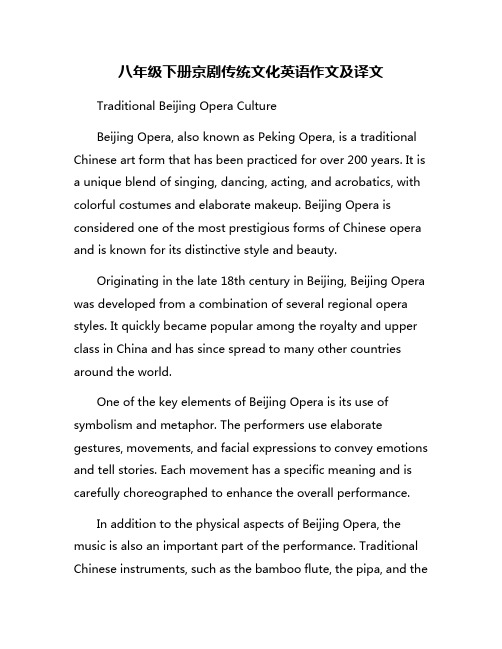
八年级下册京剧传统文化英语作文及译文Traditional Beijing Opera CultureBeijing Opera, also known as Peking Opera, is a traditional Chinese art form that has been practiced for over 200 years. It is a unique blend of singing, dancing, acting, and acrobatics, with colorful costumes and elaborate makeup. Beijing Opera is considered one of the most prestigious forms of Chinese opera and is known for its distinctive style and beauty.Originating in the late 18th century in Beijing, Beijing Opera was developed from a combination of several regional opera styles. It quickly became popular among the royalty and upper class in China and has since spread to many other countries around the world.One of the key elements of Beijing Opera is its use of symbolism and metaphor. The performers use elaborate gestures, movements, and facial expressions to convey emotions and tell stories. Each movement has a specific meaning and is carefully choreographed to enhance the overall performance.In addition to the physical aspects of Beijing Opera, the music is also an important part of the performance. Traditional Chinese instruments, such as the bamboo flute, the pipa, and theerhu, are used to create a unique and captivating sound. The music adds depth and emotion to the performance and helps to enhance the storytelling.Another important aspect of Beijing Opera is the elaborate costumes and makeup. The performers wear brightly colored costumes with intricate designs and patterns. The makeup is also very elaborate, with bold colors and exaggerated features to help the audience easily distinguish between characters.One of the most famous aspects of Beijing Opera is the "jing," or painted face, characters. These characters are known for their brightly painted masks, which symbolize their personality and traits. The colors and designs of the masks help to convey the character's emotions and intentions to the audience.Overall, Beijing Opera is a beautiful and intricate art form that showcases the traditional culture and heritage of China. It is a true testament to the creativity and talent of the Chinese people and continues to be a cherished and respected tradition.京剧传统文化京剧,又称为北京京剧,是一种传统的中国艺术形式,已有200多年的历史。
高考英语作文 介绍京剧
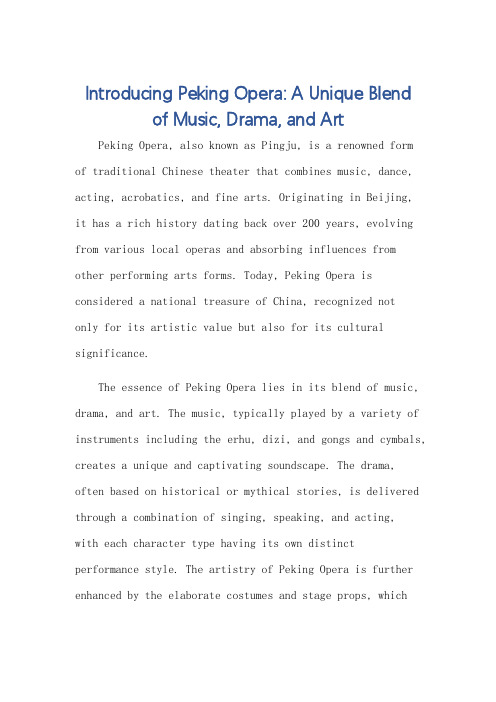
Introducing Peking Opera: A Unique Blendof Music, Drama, and ArtPeking Opera, also known as Pingju, is a renowned formof traditional Chinese theater that combines music, dance, acting, acrobatics, and fine arts. Originating in Beijing,it has a rich history dating back over 200 years, evolving from various local operas and absorbing influences fromother performing arts forms. Today, Peking Opera is considered a national treasure of China, recognized notonly for its artistic value but also for its cultural significance.The essence of Peking Opera lies in its blend of music, drama, and art. The music, typically played by a variety of instruments including the erhu, dizi, and gongs and cymbals, creates a unique and captivating soundscape. The drama,often based on historical or mythical stories, is delivered through a combination of singing, speaking, and acting,with each character type having its own distinct performance style. The artistry of Peking Opera is further enhanced by the elaborate costumes and stage props, whichreflect the beauty and richness of traditional Chinese culture.One of the most distinctive features of Peking Opera is its character types, which are known as xingjiao. These include the sheng (male lead), dan (female lead),净 (jing, painted face male characters), chou (clown), and wu (martial arts performer). Each xingjiao has its own unique performance style, voice type, and costume, allowing actors to create vivid and memorable characters.Another noteworthy aspect of Peking Opera is its emphasis on virtual performance. Instead of relying on elaborate stage sets, actors use mime, gesture, and body language to create a vivid and imaginary world. This style of performance not only requires exceptional acting skills but also allows the audience to engage their imaginations and connect more deeply with the story.Peking Opera's influence extends beyond the theater, penetrating various aspects of Chinese society and culture. It has been a significant influence on Chinese literature, art, and even fashion, serving as a powerful medium for the transmission of traditional values and stories.In conclusion, Peking Opera is a unique and compelling form of theater that combines music, drama, and art in away that is both entertaining and educational. Its rich history, diverse character types, and emphasis on virtual performance make it a truly remarkable cultural phenomenon. As we celebrate the beauty and diversity of world cultures, it is important to appreciate and preserve the richheritage of Peking Opera, a testament to the enduringspirit of Chinese culture.**京剧:音乐、戏剧与艺术的完美结合**京剧,又称平剧,是一种享有盛誉的中国传统戏剧形式,它融合了音乐、舞蹈、表演、杂技和美术等多种元素。
中国传统文化之---京剧(中英文)
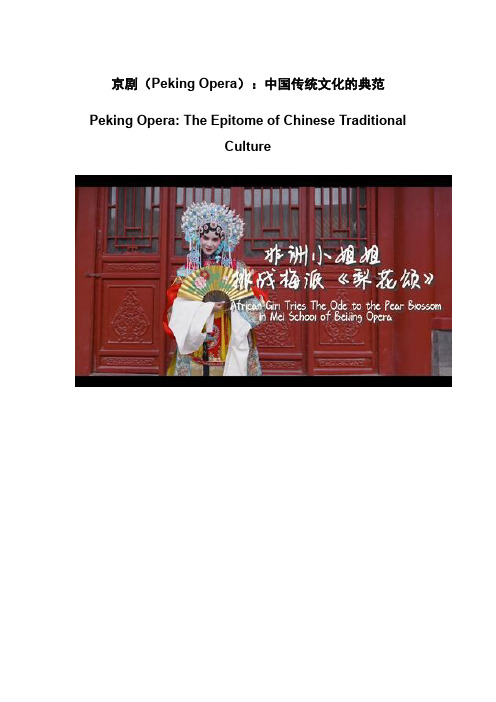
京剧(Peking Opera):中国传统文化的典范Peking Opera: The Epitome of Chinese TraditionalCulture京剧(Peking Opera),a mesmerizing art form that has captivated audiences for centuries, showcases the essence of Chinese traditional culture. With its unique blend of singing, acting, martial arts, and vibrant costumes, Peking Opera offers a window into the rich history and values of China.Originating in the late 18th century, Peking Opera combines various elements such as music, dance, and acrobatics to portray historical events, myths, and legends. Its stylized movements, intricate makeup, and elaborate costumes create a visually stunning spectacle.The performers, trained from an early age, master the art of expressing emotions through subtle gestures and nuanced vocal techniques. Each character in Peking Opera represents a specific role and personality, and the actors skillfully convey their emotions and thoughts to the audience.The storytelling in Peking Opera is accompanied by a distinctive musical ensemble, featuring traditional Chinese instruments like the erhu, pipa, and bamboo flute. The melodic tunes and rhythmic patterns enhance the dramatic impact and create a unique atmosphere.Peking Opera serves as a cultural treasure, preserving traditional values, moral lessons, and historical narratives. It continues to inspire and educate audiences, both in China and around the world, about the rich heritage of Chinese civilization.京剧(Peking Opera):中国传统文化的典范京剧是一种迷人的艺术形式,几个世纪以来一直吸引着观众,展示了中国传统文化的精髓。
传统文化京剧英语作文100字
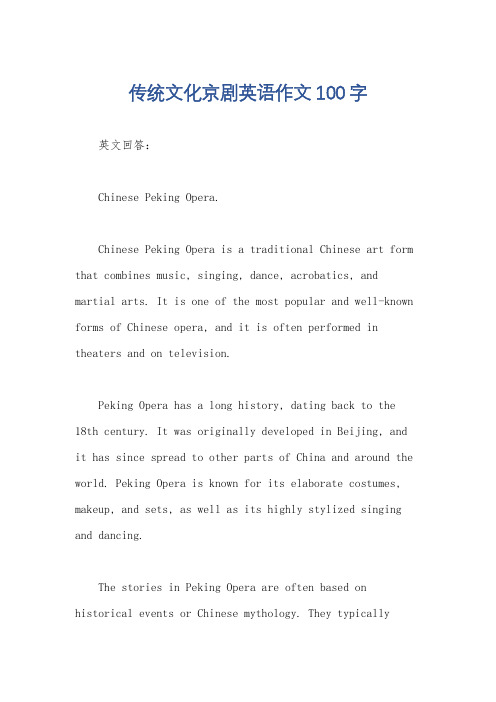
传统文化京剧英语作文100字英文回答:Chinese Peking Opera.Chinese Peking Opera is a traditional Chinese art form that combines music, singing, dance, acrobatics, and martial arts. It is one of the most popular and well-known forms of Chinese opera, and it is often performed in theaters and on television.Peking Opera has a long history, dating back to the18th century. It was originally developed in Beijing, and it has since spread to other parts of China and around the world. Peking Opera is known for its elaborate costumes, makeup, and sets, as well as its highly stylized singing and dancing.The stories in Peking Opera are often based on historical events or Chinese mythology. They typicallyinvolve a conflict between good and evil, and they often feature heroes and villains. Peking Opera is a very expressive art form, and the actors use their voices, bodies, and faces to convey the emotions of the characters.Peking Opera is a unique and beautiful art form that is enjoyed by people all over the world. It is a testament to the rich cultural heritage of China, and it continues to be an important part of Chinese culture today.中文回答:京剧。
英语作文介绍中国传统文化京剧
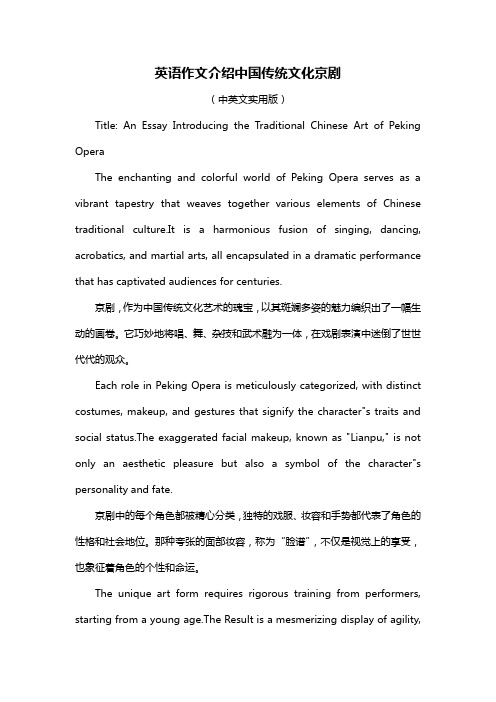
英语作文介绍中国传统文化京剧(中英文实用版)Title: An Essay Introducing the Traditional Chinese Art of Peking OperaThe enchanting and colorful world of Peking Opera serves as a vibrant tapestry that weaves together various elements of Chinese traditional culture.It is a harmonious fusion of singing, dancing, acrobatics, and martial arts, all encapsulated in a dramatic performance that has captivated audiences for centuries.京剧,作为中国传统文化艺术的瑰宝,以其斑斓多姿的魅力编织出了一幅生动的画卷。
它巧妙地将唱、舞、杂技和武术融为一体,在戏剧表演中迷倒了世世代代的观众。
Each role in Peking Opera is meticulously categorized, with distinct costumes, makeup, and gestures that signify the character"s traits and social status.The exaggerated facial makeup, known as "Lianpu," is not only an aesthetic pleasure but also a symbol of the character"s personality and fate.京剧中的每个角色都被精心分类,独特的戏服、妆容和手势都代表了角色的性格和社会地位。
- 1、下载文档前请自行甄别文档内容的完整性,平台不提供额外的编辑、内容补充、找答案等附加服务。
- 2、"仅部分预览"的文档,不可在线预览部分如存在完整性等问题,可反馈申请退款(可完整预览的文档不适用该条件!)。
- 3、如文档侵犯您的权益,请联系客服反馈,我们会尽快为您处理(人工客服工作时间:9:00-18:30)。
传统文化京剧的介绍(传统文化京剧的介绍英语)今天给各位分享传统文化京剧的介绍的知识,其中也会对传统文化京剧的介绍英语进行解释,如果能碰巧解决你现在面临的问题,别忘了关注文库,现在开始吧!本文目录:1、京剧的历史2、什么是京剧?3、京剧的来历传统文化的国粹京剧是怎么来的京剧的历史关于京剧起源:清朝庚戌年(公元一七九零年)九月二十一日是乾隆皇帝的八旬“万寿”。
全国各省有名的戏班,都被召进北京演戏庆寿。
首先,“安庆徽”戏班的名旦高郎亭应命率“三庆班”入京祝寿,随后,“四喜”、“春台”、“和春”也接踵而来。
这是徽戏第一次登上北京的戏曲舞台。
当时,被统称为“四大徽班”。
“四大徽班”为乾隆皇帝的八旬“万寿”的庆典演出结束后,没有南返,留在了北京。
从当年的十月中旬起,他们就转入民间戏曲舞台献艺了。
京剧的正式形成大约是道光二十年(1840年)以后的事。
有一批具有京剧特点的剧目,京剧第一代演员也已经出现,程长庚是这一时期的代表人物。
京剧的传统剧目约在一千多个,常演的约有三四百个以上。
京剧较擅长于表现历史题材的政治和军事斗争,故事大多取自历史演义和小说话本。
既有整本的大戏,也有大量的折子戏,此外还有一些连台本戏。
同治六年(1867),京剧传到上海。
从而使之成为与北京并立的另一个京剧中心。
京剧在进入上海之前,即咸丰十年(1860)之后,随商旅往来及戏班的流动演出,很快传播到全国各地。
1919年,梅兰芳率剧团赴日本演出,京剧艺术首次向海外传播,此后,世界各地把京剧看成中国的演剧学派。
京剧的兴起:1883年-1918年,京剧由形成期步入成熟期,代表人物为时称“老生后三杰”的谭鑫培、汪桂芬、孙菊仙。
1917年以来,京剧优秀演员大量涌现,呈现出流派纷呈的繁盛局面,由成熟期发展到鼎盛期,这一时期的代表人物为杨小楼、梅兰芳、余叔岩。
由于文人崇尚的雅文化传统在20世纪遭遇灭顶之灾,京剧达到了它的全盛时期。
20世纪60年代,由于历史原因,京剧遭遇重创,在此不便详述。
什么是京剧?,又称平剧、京戏等,是中国影响最大的戏曲剧种,分布地以北京为中心,遍及全国各地。
[1]清代乾隆五十五年(1790年)起,原在南方演出的三庆、四喜、春台、和春[1]四大徽班陆续进入北京,与来自湖北的汉调艺人合作,同时接受了昆曲、秦腔的部分剧目、曲调和表演方法,又吸收了一些地方民间曲调,通过不断的交流、融合,最终形成京剧。
[1]京剧在文学、表演、音乐、舞台美术等各个方面都有一套规范化的艺术表现形式。
京剧的唱腔属板式变化体,以二簧、西皮为主要声腔。
京剧伴奏分文场和武场两大类,文场以胡琴为主奏乐器,武场以鼓板为主。
京剧的角色分为生、旦、净、丑、杂、武、流等行当,后三行已不再立专行。
各行当都有一套表演程式,唱念做打的技艺各具特色。
京剧以历史故事为主要演出内容,传统剧目约有一千三百多个,常演的在三四百个以上。
[1]京剧流播全国,影响甚广,有“国剧”之称。
以梅兰芳命名的京剧表演体系被视为东方戏剧表演体系的代表,为世界三大表演体系之一。
京剧是中华民族传统文化的重要表现形式,其中的多种艺术元素被用作中国传统文化的象征符号。
[1]2006年5月,京剧被国务院批准列入第一批国家级非物质文化遗产名录。
[2]2010年,被列入联合国教科文组织非物质文化遗产名录(名册)人类非物质文化遗产代表作名录[3]。
中文名京剧批准时间2006年5月非遗级别第一批国家级非物质文化遗产申报地区北京市、天津市、辽宁省、上海市、山东省等外文名BeijingOperaPekingOpera京剧小舞台中的大天地【课】6082播放京剧代表剧目更多共24个词条宇宙锋《宇宙锋》是中国戏曲的传统剧目,而梅兰芳(京剧)、陈素真(豫剧)、陈伯华(玉堂春《玉堂春》不仅是京剧旦角的开蒙戏,还是中国戏曲中流传最广的剧目之一。
此剧是清代花部乱弹作品,作者不详,故事见冯梦龙编订长坂坡《长坂坡》是京剧传统剧目,主体是取自于《三国演义》第41回“……赵子龙单骑救主”。
该剧目将赵云的救刘禅事件、文鸯的七进七群英会《群英会》是依据《三国演义》第45回“……群英会蒋干中计”改编的传统京剧,故事叙述:曹操谋士蒋干,与周瑜故交,请求过江劝京剧四大流派更多共4个词条梅派由梅兰芳创立程派由程砚秋创立荀派由荀慧生创立尚派由尚小云创立京剧“四大名旦”更多共4个词条梅兰芳程砚秋代表作品:《春闺梦》尚小云代表作品:《昭君出塞》荀慧生代表作品:《红娘》京剧四大脸谱更多共4个词条丑京剧四大脸谱净京剧四大脸谱旦京剧四大脸谱生京剧四大脸谱我国知名京剧表演艺术家更多共13个词条沈福存周云亮代表作:《拿高登》朱秉谦代表作:《四进士》李鸣岩代表作:《太君辞朝》中国十大戏曲更多共10个词条京剧京剧,又称平剧、京戏等,是中国影响最大的戏曲剧种,分布地以北京为中心,遍及全国各地。
清代乾隆五十五年(1790年)起,原昆曲昆曲(KunOpera),原名“昆山腔”(简称“昆腔”),是中国古老的戏曲豫剧豫剧(英文:HenanOpera),发源于中原(河南开封)。
是我国最大的地方剧种,居全国各地方戏曲之首。
豫剧是在河南梆评剧评剧,流传于中国北方,是汉族传统戏曲剧种之一,是广大人民所喜闻乐见的剧种之一,位列中国五大戏曲剧种。
曾有观点认为是中国第中国的世界级非物质文化遗产更多共42个词条太极拳入选时间:2020年送王船入选时间:2020年藏医药浴法入选时间:2018年二十四节气入选时间:2016年快速导航文化特征代表剧目传承保护主要流派社会影响戏曲评价历史沿革起源期徽州商人富甲一方,商业的成功引发了文化消费欲望的高涨[5]。
随着社会经济的发展和戏曲声腔昆山腔的兴起,纷纷蓄养家班,角色斗艺,并卖力为乾隆下江南收集声色歌舞,不惜重金包装徽剧色艺,客观上为徽剧进京创造了条件。
雄霸明清商界500余年的徽州商帮以盐商出名,黄山歙县的盐商尤其出名,富甲一方。
随着社会经济的发展和戏曲声腔昆山腔的兴起,江南江北文人士大夫和富商巨贾纷纷蓄养家庭戏班。
已经在外地商界崭露头角的徽商也纷纷效仿。
长期为某个徽州商人所养所用的戏曲班社就被外人称为“徽班”。
徽商广蓄家班,安徽沿江一带,包括古徽州的地方戏也开始兴盛。
他们唱昆腔,由于语言的差异而不“谐吴音”,不经意间唱出了一点。
尤以诞生在安徽安庆市怀宁县的石牌调最著名。
徽州艺人带着乡音下扬州,得到了徽商们的亲情惠顾和重金扶持。
他们或出没于码头街肆,或为徽商富贾所容留。
技艺得到发展,乡音也渐占上风。
值得一提的是,歙县大盐商江春,是一位品味极高的戏曲鉴赏家,他酷爱戏曲,家中常常“曲剧三四部,同日分亭馆宴客,客至以数百计”。
他把各种名角聚在一起,又让不同声腔同台互补,使异军突起的徽班具有了博采众长的开放格局。
“乱弹”乱唱,红火异常。
这时最叫彩的是来自安庆的戏曲艺人,清李斗在《扬州画舫录》中就这样写道:安庆色艺最优,盖于本地乱弹,故本地乱弹间有聘之入班者。
徽商在商界进一步站稳了脚跟,他们和戏曲艺术的关系也越来越密切。
而涌现出大批戏曲家的“徽班”,也在新的历史条件下得到了进一步的发展。
同光十三绝石牌是安庆市怀宁县一个古老的集镇,“无石不成班”的“石”即指这里,也泛指安庆及其所属各千艘。
江西、福建、湖北等地客商纷纷在此设馆驻节。
当时的石牌除本地居民外,大都是过往船帮和商户,在生存问题变得比较轻松的时候,他们开始构建自己的市井文化。
石牌当时可供表演的戏剧舞台多达800处,不仅有戏园、戏楼,还有花戏台。
戏园,在石牌镇就有3家。
上镇横街的长乐大戏院可容纳观众600多人,专供徽调、皮簧班演出。
戏楼通常在祠堂内。
祠堂戏楼通常只唱大戏,每年做冬至节、族内有人中举、升官以及族内官绅庆寿等,都要聘戏班在戏楼演出。
此外,祠堂大修落成,也必邀班唱戏以示祝贺。
《都剧赋》描述:“徽班日失丽,始自石牌”。
表明安庆的徽班历史上曾经出现过辉煌,很多京剧前辈名伶都是这一带的人,因而有“无石不成班”的说法。
在石牌的弹丸之地涌现出了郝天秀、程长庚、杨月楼等多位开一代风气的色艺最优,”“无石(牌)不成班!”之说一时间广为流传。
细心的京剧票友不难发现,京剧的唱腔中有很多字辞的发音是与北京方言不相同的,如果你对安庆地区的方言有所了解,就会发现,这些字辞却与安庆方言里的发音一模一样。
安庆民国初期就有“民众”大戏院,当时全国京剧名角基本上都在此演出过,他们都带着“朝圣”的心情来安庆登台,戏剧大家曹禺到怀宁石牌镇,下车第一句话就是“我来朝圣”。
京剧界老科班出来的人,不在安庆演上十天,不唱连本,在当时都被认为是没有发展前途的“角”。
从安庆古镇石牌乡野间发源的徽剧,走出了古镇,走到了北京,徽班进京的辉煌历史光环至今还笼罩着古镇石牌。
安庆是中国较早接受现代文明的城市之一,也是国家历史文化名城,同时安庆还是享誉世界,极具地方特色的戏剧——黄梅戏的故乡。
程长庚纪念馆,位于安庆潜山县,馆内珍藏三百多件珍贵的实物和图片资料,再现了京剧艺术的发展兴盛历程。
此外,还有程长庚故居供戏迷瞻仰。
徽班进京的出发地在扬州,身怀绝技的优伶们,出发前一定要到位于苏唱街的梨园总局碰碰头,商量一下出发日程和演出剧目,并在那里一起摆个身段、甩两下水袖、扬几声珠圆玉润的歌喉。
有时干脆排演几出折子戏,或是《游园》,或是《思凡》,声情并茂,婀娜多姿,那时的苏唱街,十分热闹。
京剧苏唱街,是老扬州惟一保存下来的与戏班直接有关的街道。
当年盐商徐尚志从苏州招徕昆腔艺人办起的扬州第一个昆腔班“老徐班”,就在这条街上。
1790年秋,为庆祝乾隆八旬寿辰,扬州盐商江鹤亭(安徽人)在安庆组织了一个名为“三庆班”的徽戏戏班,由艺人高朗亭率领进京参加祝寿演出。
这个徽班以唱二簧调为主,兼唱昆曲、吹腔、梆子等,是个诸腔并奏的戏班。
这次北京的祝寿演出规模盛大,从西华门到西直门外高粱桥,每隔数十步设一戏台,南腔北调,四方之乐,荟萃争妍。
或弦歌高唱,或抖扇舞衫,前面还没有歇下,后面又已开场,群戏荟萃,众艺争胜。
在这场艺术竞赛当中,第一次进京的三庆徽班即崭露头角,引人瞩目。
三庆班的高朗亭是安徽安庆人,入京时才十六岁,演旦角,擅长二簧腔,技艺精湛。
《目下看花记》称他:“宛然巾帼,无分毫矫强。
不必征歌,一颦一笑,一起一坐,描摹雌软神情,几乎化境。
”三庆班进京获得成功后,又有四喜班、和春班、春台班等徽班进入北京,并逐渐称雄于京华的剧坛。
这就是所谓的“四大徽班进京”。
共7张历年新年京剧晚会片头四大徽班各有所长,有“三庆的轴子,四喜的曲子,和春的把子,春台的孩子”的说法,轴子指以连演整本大戏著称,曲子指擅长演唱昆曲,把子指以武戏取胜,孩子指以童伶见长。
在捧旦之风十分火爆的京城,技艺不凡的高朗亭自然受宠。
抵达北京后,他接替原三庆班班主余老四掌班,一做就是30多年,同时还担任了京师戏曲界行会组织“精忠庙”的会首,通过精忠庙对北京的戏班、戏园实行行政管理,他也成为梨园领袖。
